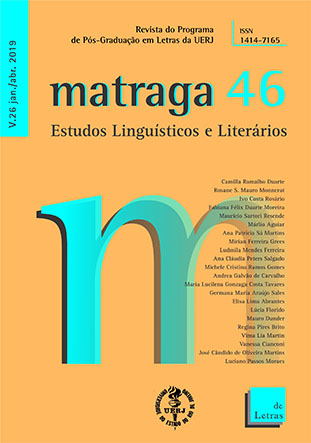In a land far, far away: writing (in) French Polynesia
DOI:
https://doi.org/10.12957/matraga.2019.37109Palavras-chave:
Literatura da Polinésia Francesa, literatura Mā’ohi, literatura pós-colonial, francofonia.Resumo
This article approaches, from a historical perspective, the contemporary literature of French Polynesia and the themes that are particular to it, a consequence of the complex relationship between the region and France. The first text about Tahiti dates back to the 18th century when the explorer Antoine de Bougainville disembarked on the island. The publication of his diary in 1771 marks the origin of a myth that promises, to this day, the possibility of an earthly paradise. Over the years, the Tahitian mirage was consolidated, eventually assimilating the 118 islands that make up French Polynesia and overcoming the singularities of each one of them. However, with the onset of 193 atomic detonations in the region (carried out by the French government between 1966 and 1996), the environment became conducive to the birth of the movement aimed at restoring ancestral languages and cultures. Instead of stories written by foreign authors about French Polynesia, native writers decided to take control of the narrative, which proposes to reflect the Mā’ohi identity as it exists within the context of living under the rule of France. Today, this literary body, more substantial and prominent as the cultural revolution grew in scope, is regarded by academics as the youngest in the world. If books in print still face intellectual prejudices and high costs, the internet has created copious opportunities for publishing online, allowing local authors to transcend the insularity that has limited them for centuries.
-----------------------------------------------------------------------------------------
NUM PAÍS MUITO DISTANTE: ESCREVENDO (N)A POLINÉSIA FRANCESA
Este artigo aborda, a partir de uma perspectiva histórica, a literatura contemporânea da Polinésia Francesa e os temas a ela particulares, consequência da relação complexa existente entre a região e a França. O primeiro texto sobre o Taiti data do século XVIII, quando o explorador Louis Antoine de Bougainville aí desembarcou. A publicação de seu diário em 1771 marca a origem de um mito que promete, até os dias de hoje, a possibilidade de um paraíso terrestre. Com o passar dos anos, a miragem do Taiti se consolidou, acabando por assimilar as 118 ilhas que compõem a Polinésia Francesa e por suplantar as singularidades de cada uma delas. No entanto, com o início das 193 detonações atômicas na região (efetuadas pelo governo francês entre 1966 e 1996), o ambiente se tornou propicio para a inauguração do movimento que visava restaurar as línguas e culturas ancestrais. Em vez de histórias escritas por autores estrangeiros sobre a Polinésia Francesa, escritores nativos decidiram assumir o controle da narrativa, que propõe refletir a identidade Mā’ohi tal qual ela existe no contexto do domínio francês. Este corpo literário, mais substancial e proeminente à medida que a revolução cultural cresceu em escopo, é atualmente considerado pelos acadêmicos como o mais jovem do mundo. Se livros impressos ainda enfrentam preconceitos e altos custos, a internet criou oportunidades copiosas para que se possa publicar online, permitindo que os autores locais transcendam a insularidade que por séculos os limitou.
---
Original em inglês.
Downloads
Downloads
Publicado
Como Citar
Edição
Seção
Licença
AUTORIZAÇÃO
A Matraga – Revista do Programa de Pós-Graduação em Letras da UERJ está autorizada a publicar o artigo ora submetido, caso seja aceito para publicação online. Fica atestado que a contribuição é original, que não está sendo submetida a outro editor para publicação, e que a presente declaração é a expressão da verdade.
Os trabalhos publicados no espaço virtual da Matraga – Revista do Programa de Pós-Graduação em Letras da UERJ serão automaticamente cedidos, ficando os seus direitos autorais reservados à Matraga. Sua reprodução, total ou parcial, é condicionada à citação dos autores e dos dados da publicação.

A Matraga utiliza uma Licença Creative Commons - Atribuição-NãoComercial 4.0 Internacional.





